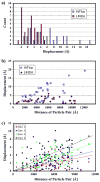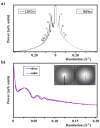A dose-rate effect in single-particle electron microscopy
- PMID: 17977018
- PMCID: PMC2213720
- DOI: 10.1016/j.jsb.2007.09.017
A dose-rate effect in single-particle electron microscopy
Erratum in
- J Struct Biol. 2008 Nov;164(2):240
Abstract
A low beam intensity, low electron dose imaging method has been developed for single-particle electron cryo-microscopy (cryo-EM). Experiments indicate that the new technique can reduce beam-induced specimen movement and secondary radiolytic effects, such as "bubbling". The improvement in image quality, especially for multiple-exposure data collection, will help single-particle cryo-EM to reach higher resolution.
Figures






Similar articles
-
Cryo-EM Structure Determination Using Segmented Helical Image Reconstruction.Methods Enzymol. 2016;579:307-28. doi: 10.1016/bs.mie.2016.05.034. Epub 2016 Jun 28. Methods Enzymol. 2016. PMID: 27572732 Review.
-
Combining high throughput and high quality for cryo-electron microscopy data collection.Acta Crystallogr D Struct Biol. 2020 Aug 1;76(Pt 8):724-728. doi: 10.1107/S2059798320008347. Epub 2020 Jul 27. Acta Crystallogr D Struct Biol. 2020. PMID: 32744254 Free PMC article. Review.
-
Volta phase plate data collection facilitates image processing and cryo-EM structure determination.J Struct Biol. 2018 Jun;202(3):191-199. doi: 10.1016/j.jsb.2018.01.003. Epub 2018 Jan 11. J Struct Biol. 2018. PMID: 29337113
-
AutoCryoPicker: an unsupervised learning approach for fully automated single particle picking in Cryo-EM images.BMC Bioinformatics. 2019 Jun 13;20(1):326. doi: 10.1186/s12859-019-2926-y. BMC Bioinformatics. 2019. PMID: 31195977 Free PMC article.
-
Ultrastable gold substrates: Properties of a support for high-resolution electron cryomicroscopy of biological specimens.J Struct Biol. 2016 Jan;193(1):33-44. doi: 10.1016/j.jsb.2015.11.006. Epub 2015 Nov 22. J Struct Biol. 2016. PMID: 26592474 Free PMC article.
Cited by
-
Electron Tomography: A Three-Dimensional Analytic Tool for Hard and Soft Materials Research.Adv Mater. 2015 Oct 14;27(38):5638-63. doi: 10.1002/adma.201501015. Epub 2015 Jun 18. Adv Mater. 2015. PMID: 26087941 Free PMC article. Review.
-
Temporal dynamics of charge buildup in cryo-electron microscopy.J Struct Biol X. 2022 Dec 30;7:100081. doi: 10.1016/j.yjsbx.2022.100081. eCollection 2023. J Struct Biol X. 2022. PMID: 36632442 Free PMC article.
-
A fast cross-validation method for alignment of electron tomography images based on Beer-Lambert law.J Struct Biol. 2015 Nov;192(2):297-306. doi: 10.1016/j.jsb.2015.10.004. Epub 2015 Oct 9. J Struct Biol. 2015. PMID: 26455556 Free PMC article.
-
The advent of structural biology in situ by single particle cryo-electron tomography.Biophys Rep. 2017;3(1):17-35. doi: 10.1007/s41048-017-0040-0. Epub 2017 May 29. Biophys Rep. 2017. PMID: 28781998 Free PMC article.
-
A test-bed for optimizing high-resolution single particle reconstructions.J Struct Biol. 2008 Jul;163(1):29-39. doi: 10.1016/j.jsb.2008.04.005. Epub 2008 May 6. J Struct Biol. 2008. PMID: 18534866 Free PMC article.
References
-
- Frank J. Single-particle imaging of macromolecules by cryo-electron microscopy. Annu Rev Biophys Biolol Struct. 2002;31:303–19. - PubMed
-
- Glaeser RM, Taylor KA. Radiation damage relative to transmission electron microscopy of biological specimens at low temperature: a review. J Microsc. 1978;112:127–38. - PubMed
-
- Cosslett VE. Radiation damage in the high resolution electron microscopy of biological materials: a review. J Microsc. 1978;113:113–29. - PubMed
-
- Downing KH, Glaeser RM. Improvement in high resolution image quality of radiation-sensitive specimens achieved with reduced spot size of the electron beam. Ultramicroscopy. 1986;20:269–78. - PubMed
-
- Misra M, Egerton RF. Assessment of electron irradiation damage to biomolecules by electron diffraction and electron energy-loss spectroscopy. Ultramicroscopy. 1984;15:337–43. - PubMed
Publication types
MeSH terms
Grants and funding
LinkOut - more resources
Full Text Sources
Other Literature Sources
